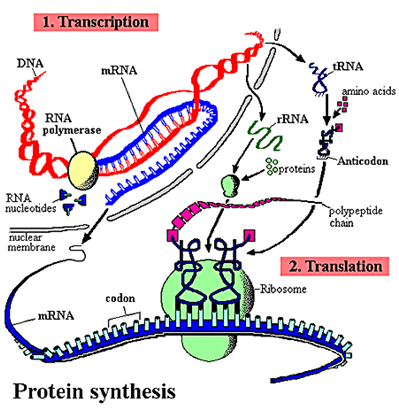Anabolism is the process by which the body utilizes the energy released by catabolism to synthesize complex molecules. These complex molecules are then utilized to form cellular structures that are formed from small and simple precursors that act as building blocks.
Stages of anabolism
There are three basic stages of anabolism.
- Stage 1 involves production of precursors such as amino acids, monosaccharides, isoprenoids and nucleotides.
- Stage 2 involves activation of these precursors into reactive forms using energy from ATP
- Stage 3 involves the assembly of these precursors into complex molecules such as proteins, polysaccharides, lipids and nucleic acids.
Sources of energy for anabolic processes
Different species of organisms depend on different sources of energy. Autotrophs such as plants can construct the complex organic molecules in cells such as polysaccharides and proteins from simple molecules like carbon dioxide and water using sunlight as energy.
Heterotrophs, on the other hand, require a source of more complex substances, such as monosaccharides and amino acids, to produce these complex molecules. Photoautotrophs and photoheterotrophs obtain energy from light while chemoautotrophs and chemoheterotrophs obtain energy from inorganic oxidation reactions.
Anabolism of carbohydrates
In these steps simple organic acids can be converted into monosaccharides such as glucose and then used to assemble polysaccharides such as starch. Glucose is made from pyruvate, lactate, glycerol, glycerate 3-phosphate and amino acids and the process is called gluconeogenesis. Gluconeogenesis converts pyruvate to glucose-6-phosphate through a series of intermediates, many of which are shared with glycolysis.
Usually fatty acids stored as adipose tissues cannot be converted to glucose through gluconeogenesis as these organisms cannot convert acetyl-CoA into pyruvate. This is the reason why when there is long term starvation, humans and other animals need to produce ketone bodies from fatty acids to replace glucose in tissues such as the brain that cannot metabolize fatty acids.
Plants and bacteria can convert fatty acids into glucose and they utilize the glyoxylate cycle, which bypasses the decarboxylation step in the citric acid cycle and allows the transformation of acetyl-CoA to oxaloacetate. From this glucose is formed.
Glycans and polysaccharides are complexes of simple sugars. These additions are made possible by glycosyltransferase from a reactive sugar-phosphate donor, such as uridine diphosphate glucose (UDP-glucose), to an acceptor hydroxyl group on the growing polysaccharide. The hydroxyl groups on the ring of the substrate can be acceptors and thus polysaccharides produced can have straight or branched structures. These polysaccharides so formed may be transferred to lipids and proteins by enzymes called oligosaccharyltransferases.
Anabolism of proteins
Proteins are formed of amino acids. Most organisms can synthesize some of the 20 common amino acids. Most bacteria and plants can synthesize all twenty, but mammals can synthesize only the ten nonessential amino acids.
The amino acids are joined together in a chain by peptide bonds to form polypeptide chains. Each different protein has a unique sequence of amino acid residues: this is its primary structure. The polypeptide chain undergoes modifications, folding and structural changes to form the final protein.

Nucleotides are made from amino acids, carbon dioxide and formic acid in pathways that require large amounts of metabolic energy.
Purines are synthesized as nucleosides (bases attached to ribose). Adenine and guanine for example are made from the precursor nucleoside inosine monophosphate, which is synthesized using atoms from the amino acids glycine, glutamine, and aspartic acid, as well as formate transferred from the coenzyme tetrahydrofolate.
Pyrimidines, like thymine and cytosine, are synthesized from the base orotate, which is formed from glutamine and aspartate.
Anabolism of fatty acids
Fatty acids are synthesized using fatty acid synthases that polymerize and then reduce acetyl-CoA units. These fatty acids contain acyl chains that are extended by a cycle of reactions that add the actyl group, reduce it to an alcohol, dehydrate it to an alkene group and then reduce it again to an alkane group.
In animals and fungi, all these fatty acid synthase reactions are carried out by a single multifunctional type I protein. In plants, plasmids and bacteria separate type II enzymes perform each step in the pathway.
Other lipids like terpenes and isoprenoids include the carotenoids and form the largest class of plant natural products. These compounds are made by the assembly and modification of isoprene units donated from the reactive precursors isopentenyl pyrophosphate and dimethylallyl pyrophosphate. In animals and archaea, the mevalonate pathway produces these compounds from acetyl-CoA.
Sources
- http://www.elmhurst.edu/~chm/vchembook/592energy.html
- http://www.nature.com/scitable/topicpage/dynamic-adaptation-of-nutrient-utilization-in-humans-14232807
- http://www.nature.com/scitable/topicpage/nutrient-utilization-in-humans-metabolism-pathways-14234029
- http://www.soundformulas.com/page9.html
- http://cronus.uwindsor.ca/units/biochem/web/biochemi.nsf/18e8732806421826852569830050331b/7a371e9af805f74e85256a4f00538021/$FILE/Energy%20metabolism.pdf
Further Reading
- All Metabolism Content
- What is Metabolism?
- Science of Metabolism
- Metabolism Key Biochemicals
- Metabolism Catabolism
Last Updated: Feb 26, 2019

Written by
Dr. Ananya Mandal
Dr. Ananya Mandal is a doctor by profession, lecturer by vocation and a medical writer by passion. She specialized in Clinical Pharmacology after her bachelor's (MBBS). For her, health communication is not just writing complicated reviews for professionals but making medical knowledge understandable and available to the general public as well.
Source: Read Full Article
